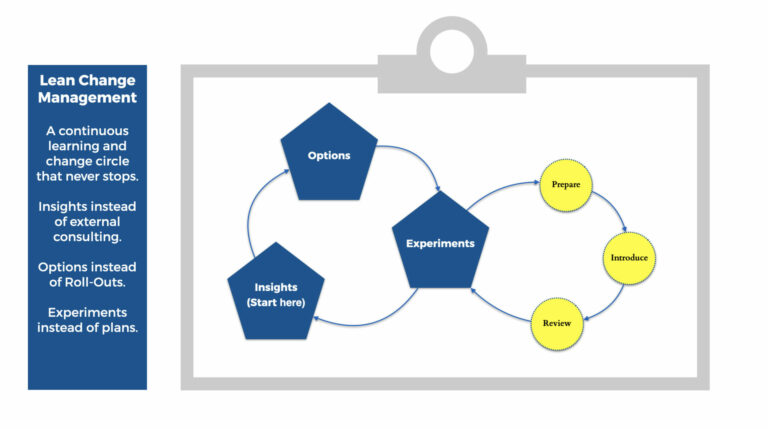5 Elements for team success
Let’s tackle one of the most frequently asked question, that comes across in business.
How can you improve your team performance?
Let’s introduce a simple model to create team success in any team, which is tangible and easy to execute. Hundreds of our customers use this easy approach to create more team success whatever the team they are working with.

“Bonding signals generate psychological safety and is the prerequisite for openly sharing mistakes / failures and achieving improvement.
In combination with setting goals based on a meaningful mission, motivation is created.
Based on a successful strategy and transparency in performance, any team can achieve high performance.”
Weert Jacobsen Kramer, 2022
1. Bonding creates trust
The first and most important factor for team success is to create a basis for joint cooperation. To do this, it is necessary to frequently exchange bonding signals with each other. Bonding signals include a friendly laugh, light touches such as handshakes or high fives, eye contact, and friendly attentions such as praise and appreciation.
Bonding signals give each team member the signal, “You are safe here! Nothing will happen to you here!” Bonding signals build trust within the team and team members don’t have to waste their energy and attention on defensive strategies.
Bonding rituals
Teams develop various rituals over time to create bonding. Shared dinners are a good example, as well as organized team activities or simply deep conversations with individual team members.
High-performing teams are true bonding champions. They are always inventing new ways to build good bonding within the team!
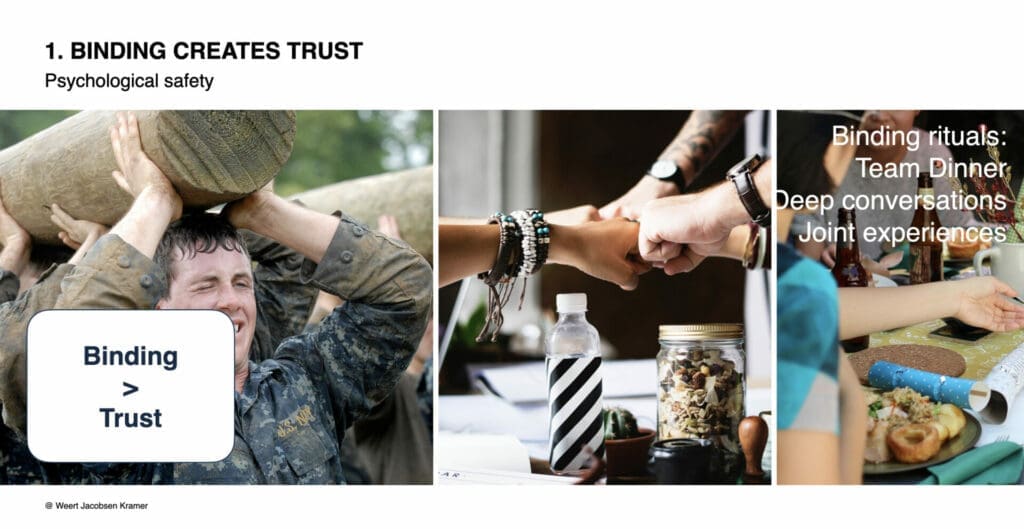
1. Open communication generates improvement
Good performance in a team is not possible without analyzing mistakes. Open communication about improvement potentials in the team are the engine for continuous improvement in the team.
Unfortunately, not all people have good experience in openly talking about their mistakes or improvement potentials. As a result, people often build defensive strategies. They avoid evaluations or always find excuses for their (non) performance.
The reason for this are the two big cultural drivers we find in most societies: Guilt and shame.
Guilt and shame
The “blame” system, i.e., who is at fault for a behavior in terms of the law, is highly developed and professionalized. Entire professions, such as lawyers, criminal attorneys, judges, etc., deal with this question day in and day out.
The “shame” system is also exceedingly dominant and permeates society to its very corners. It is evident in familiar phrases or speech patterns: “Shame on you!” and “You must think you’re something special!” and “I’m being dissed!”. Shaming fellow human beings is a ritual in our society that serves to maintain social norms.
Because these cultural drivers are so strong and the human defense mechanisms of evaluation situations are so pronounced, it is extremely important to build a good foundation for teamwork through bonding on the one hand. On the other hand, we need important role model behavior, especially from the leader.
Important behavior of the manager
A very important behavior as a leader is to communicate mistakes openly. “I made a mistake there!” “I didn’t do that right.” “I would solve that differently today!” are extremely important phrases that belong in the repertoire of every leader.
This behavior sends the signal to the team that mistakes are allowed and that it is possible to talk openly about mistakes without the threat of sanctions.
Hansei – KAIZEN – KAIRYO
I am very grateful to Jun Nakamuro for providing the exact Japanese translation some years ago and thus also the exact difference between “Hansei”, “Kaizen” and “Kairyo”. Through this differentiation, the concept of “kaizen”, which is important in lean management, can be better explained.
Hansei: “Hansei” refers to the individual attitude of “living for others”. One’s own actions are aligned with the good of society.
Kaizen: By “Kaizen” is meant the individual attitude of self-improvement. Kaizen means to question oneself, to practice self-criticism, to change the status quo. It is about fully developing one’s own potential.
Kairyo: Kairyo means continuous change in the physical world.
Team members in high-performance teams are constantly questioning themselves and trying to generate improvements from within themselves and the entire team.
High-performance teams are true improvement champions. They are always questioning themselves and talking all the time about their strengths and how the team can continue to improve!
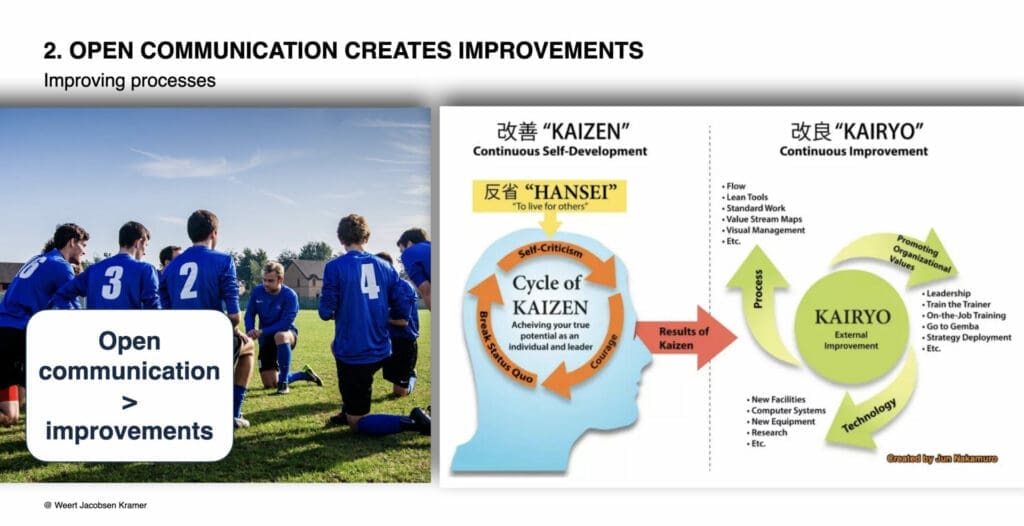
3. Purpose generates motivation
We cannot motivate or change people. People motivate and change out of themselves at the moment it makes sense to them.
The process of creating purpose
We cannot control this process of purpose generation, also called “autopoiesis”, from the outside. Humans are complex dynamic biological systems. They are determined by their structure and generate their reality again and again out of themselves. We cannot control the process of purpose generation, but we can influence it.
As a leader, keep offering explanations for the common team goal. As a leader, keep explaining why it makes sense to achieve this or that goal. While this is not a guarantee to trigger the self-change process or self-motivation, it is the only thing we can do.
Goals
Every team needs a goal to work toward. There is no question about it. Leaders do well to invest time in jointly deriving team goals. What is questionable, however, is how these goals are usually agreed upon in companies. Who is not familiar with the annual goal agreement process between managers and employees? This process can be described with a clear conscience as dysfunctional. As a rule, the result is rarely motivation, but often even demotivation.
Self-goal setting processes
A very effective way to get the process of self-change and self-motivation going are self-goal setting processes. At its core is this question, “What is my/your contribution to the success of our company in the next quarter?”
It is an effective process to ask each employee this question one quarter. The moment this question is answered seriously, self-motivation and possibly a process of self-change has been generated. Therefore, this question is very valuable.
High-performing teams are true self-change and self-motivation champions. They are always talking about what contributions everyone wants to make to the team’s success and what goals each individual sets for themselves.

4. Strategy generates performance
Another important building block for unleashing team performance is the existence of an agreed strategy within the team. Do we have a team vision? How do we plan to achieve our vision? What are our drivers through which we will achieve our vision? What goals are we taking on now to achieve our vision?
Dysfunctional teams have no strategy
Dysfunctional teams have no strategy. As a management consultant with more than 20 years of experience, I can confirm this phenomenon from my own practice. These teams may send out commitment signals, talk openly about their potential for improvement and even find their work meaningful. But if there is no coordinated strategy within the team, the team performance will remain mediocre because the team members are not working in the same direction.
Closely aligned – loosely coupled
The best strategy for managing teams is the rule: tightly aligned – loosely coupled.
People, as stated above, are complex dynamic biological systems. This complexity increases with the number of team members. In order to align this complexity, there is a need for constant coordination of the common strategy. At the same time, people behave autonomously and self-organized. Therefore, after the close alignment, it is important to loosen the reins. Let team members act in loose coupling with each other. Do not overdo the control of work progress. Control is good, but trust is better.
High-performing teams are true strategy champions. Their monthly and annual plans are full of deadlines designed to develop a common strategy, review the current strategy, and derive current common goals. Subsequently, the teams disperse and deliver their work results in a self-organized manner at their own pace.
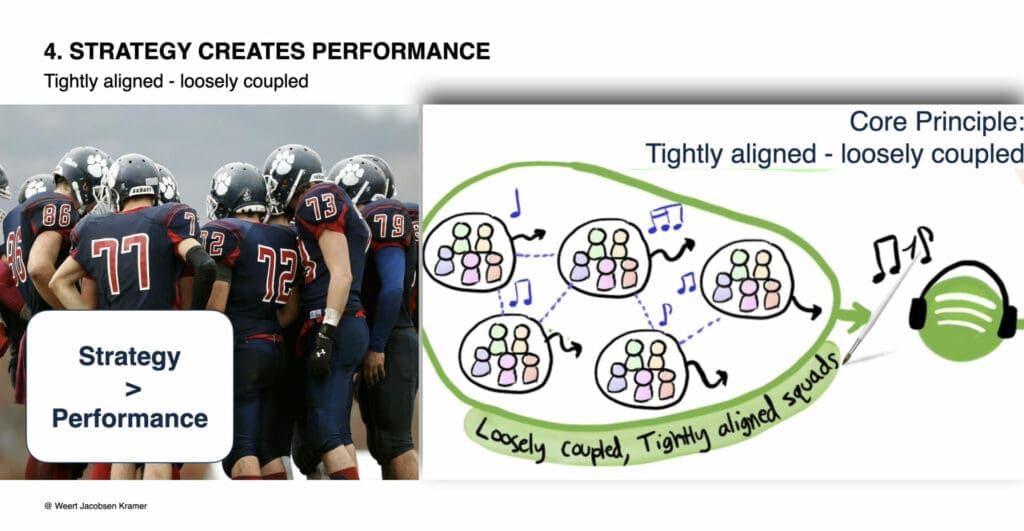
5. Transparency generates acceptance of responsibility
The last factor we need in the team is transparency about service delivery. Only then do people take responsibility for what they do and actually deliver the promised performance.
The loss of motivation in teams has become known as the Ringelmann Effect and Social Loafing.
The Ringelmann Effect
The Ringelmann Effect is considered the first social psychology experiment ever conducted. In 1882, the French agricultural engineer Maximilien Ringelmann conducted various studies in which people had to pull individual loads. Subsequently, the people pulled together on a rope in total the same weights that they had initially pulled alone.
The Ringelmann effect is the term used to describe the fact that people in a group perform less collectively physically than would be expected based on their summed individual efforts. In 1974, Ingham and colleagues took up the Ringelmann effect and paraphrased their research findings as social loafing. Both terms imply a loss of motivation in groups and a resulting drop in performance.
Social loafing
As soon as individuals work collectively with others towards a common goal and their individual performance is not known, their physiological tension is reduced. This relaxation leads to a decrease in performance on simple tasks and an increase in performance on difficult tasks, such as new or complex tasks.
Ringelmann or social laziness occurs whenever it is unclear who contributes what to the team’s performance. For example, the Ringelmann effect occurs in rope pulling, but not in the 4 by 100 relay in breaststroke. In the latter case, by accurately measuring the swimming performance of the individual swimmer, it is always apparent who is providing what performance.
Responsibility diffusion
Responsibility diffusion is the condition when it is not clear who is responsible for an action in a situation. An example from everyday life is driving on the highway, where we observe a car on the side that has broken down. Usually, hardly any drivers stop to help. It is unclear who is responsible and most motorists think, “Someone will stop.” Teams cannot perform in a state of responsibility diffusion.
Shopfloor Management
To reduce the loss of team motivation, many companies are implementing Shopfloor Management. In this system, information is shared via short daily meetings and the status of task packages is transparently agreed upon.
No help is possible without transparency
Even though the performance aspect has been emphasized here in this section, I would like to conclude by adding one more thought. How are team members supposed to support each other in the team if it is not transparent who is working on which topic and may need support there. From this perspective, transparency in task completion is absolutely necessary.
High-performance teams are true transparency champions. They like to share their work progress transparently. They are always interested in what their teammates are working on and how they can help each other.
High-performing teams have learned that diffusion of responsibility is an enemy of good team performance, and they make sure that tasks are clearly assigned.
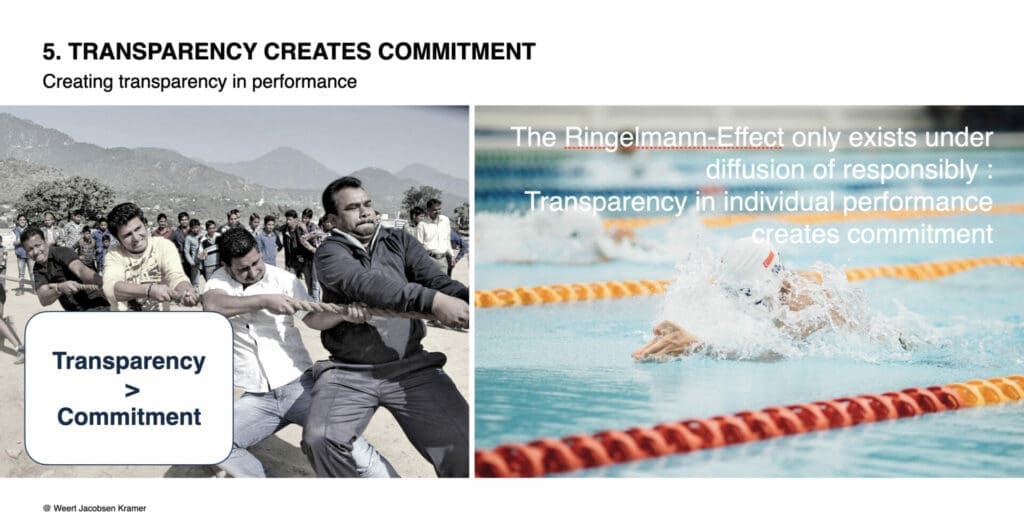
Summary
Binding signals create psychological security and is the prerequisite for openly sharing mistakes / failures and achieving improvement.
In combination with set goals based on a meaningful mission, motivation is created.
Based on a successful strategy and transparency in performance, any team can achieve high performance.
These 5 elements for team success are simple and can be implemented immediately.




